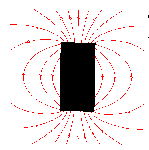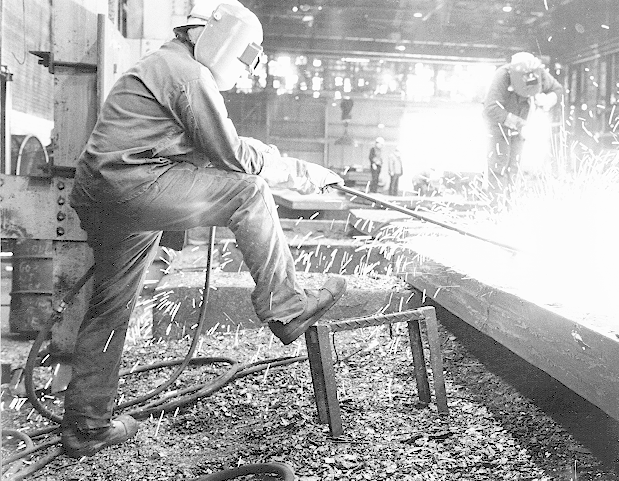EMFs In The Workplace
1996
DHHS (NIOSH) Publication Number 96-129
Everyone in our modern society is exposed to the electric and magnetic fields (EMFs) that surround all electric devices. Recently, scientific studies have raised questions about the possible health effects of EMFs. This fact sheet answers frequently asked questions about EMFs in the workplace. You can use this information to help identify EMF sources at work and to take simple steps for reducing exposures. However, you cannot use this information to judge the safety of your exposures, since the scientific evidence does not yet show whether EMF exposures are hazardous.
What are EMFs?

(Static magnetic field around a bar magnet.)
EMFs are invisible lines of force created whenever electricity is generated or used. EMFs are produced by power lines, electric wiring, and electric equipment and appliances. The frequency of EMFs is measured in hertz (Hz, or cycles per second). People are exposed to both electric and magnetic fields, but scientists are most concerned about magnetic fields. This fact sheet deals only with magnetic fields that have frequencies near 60 Hz the frequency of electric power in North America.
What do we know about workplace exposures to EMFs?
Workers may be exposed to high magnetic fields if they work near electrical systems that use large amounts of electric power (for example, large electric motors, generators, or the power supply or electric cables of a building). High magnetic fields are also found near power saws, drills, copy machines, electric pencil sharpeners, and other small electric appliances. The strength of the magnetic field depends on equipment design and current flow not on equipment size, complexity, or voltage. Though some electric equipment produces EMFs of other frequencies, most health research has considered only frequencies near 60 Hz.

These electric heaters for metal parts expose workers to magnetic fields that are 10,000 times greater than the average magnetic fields found outside the workplace.
What are some typical EMF exposures on the job?
The EMF exposures for many jobs have not been measured, but the following table shows average exposures to magnetic fields for typical workers who use electric equipment. Exposures during a work shift vary with the strength of the magnetic field, the worker s distance from the EMF source, and the time the worker spends in the field. For comparison, the table also lists worker exposures off the job.
Average magnetic field exposures for various types of workers (in milligauss)*
| Type of Worker | Average Daily Median** | Exposures Range |
|---|---|---|
| Workers on the job: | ||
| Clerical workers without computers | 0.5 | 0.2 - 2.0 |
| Clerical workers with computers | 1.2 | 0.5 - 4.5 |
| Machinists | 1.9 | 0.6 - 27.6 |
| Electric line workers | 2.5 | 0.5 - 34.8 |
| Electricians | 5.4 | 0.8 - 34.0 |
| Welders | 8.2 | 1.7 - 96.0 |
| Workers off the job (home, travel, etc.) | 0.9 | 0.3 - 3.7 |
*Magnetic fields are often measured in gauss or milligauss (one thousandth of a gauss = 1 milligauss).
**The median is the middle measurement: half the workers have average daily exposures above this point and half below.
Do EMFs cause cancer or other health effects?
Studies have shown that some workers exposed to high magnetic fields have increased cancer rates. But such associations do not necessarily show that EMF exposures cause cancer (any more than the springtime association of robins and daffodils shows that one causes the other). Scientists have looked carefully at all the EMF evidence, but they disagree about the health effects of EMFs except to say that better information is needed.
What DO studies show about the health effects of EMFs in workers?
Many studies report small increases in the rate of leukemia or brain cancer in groups of people living or working in high magnetic fields. Other studies have found no such increases. The most important data come from six recent studies of workers wearing EMF monitors to measure magnetic fields. All but one study found significantly higher cancer rates for men with average workday exposures above 4 milligauss. However, the results of these studies disagree in important ways such as the type of cancer associated with EMF exposures. So scientists cannot be sure whether the increased risks are caused by EMFs or by other factors. A few preliminary studies have also associated workplace EMFs with breast cancer, and one study has reported a possible link between occupational EMF exposure and Alzheimer s disease.
The data from all of these studies are too limited for scientists to draw conclusions. However, a national research effort is under way, and more study results are expected in a few years.

No increased leukemia has been reported overall in studies of welders, yet they are among the occupations with the highest EMF exposures.
Have limits been set for worker exposures to EMFs?
Because of the scientific uncertainty, no Federal limits for worker exposures to EMFs have been recommended or established in the United States. Two private organizations have developed guidelines to protect workers from the known effects of extremely high exposures (that is, those more than 1,000 times the exposures typically found in occupational environments). However, these guidelines do not address the possible health effects of the low EMF exposures usually found on the job.
Should workers and employers try to reduce exposures to EMFs?
The National Institute for Occupational Safety and Health (NIOSH) and other government agencies do not consider EMFs a proven health hazard. Because some studies have associated high magnetic field exposures with increased cancer risks, the government will continue studying EMFs. While research continues, concerned workers and employers might consider the following simple, inexpensive measures for reducing EMF exposures:
- Inform workers and employers about possible hazards of magnetic fields.
- Increase the worker's distance from the EMF source. Since magnetic fields often drop off dramatically within about 3 feet of the source, workers can stand back from electrical equipment, and work stations can be moved out of the 3-ft range of stronger EMF sources.
- Use low-EMF designs wherever possible (for the layout of office power supplies, for example).
- Reduce EMF exposure times. No action should be taken to reduce EMF exposure if it increases the risk of a known safety or health hazard such as electrocution.

EMF exposures depend on the worker's distance from the source.
What is NIOSH doing about EMF exposures?
NIOSH has been evaluating the possible health effects of EMFs since 1991. NIOSH scientists have measured the fields in workplaces where employees are concerned about their EMF exposures; they are also studying the biological effects of EMFs. In addition, NIOSH scientists work cooperatively with researchers in universities and other Federal agencies to share their study results. These cooperative efforts have increased recently under the National EMF Research and Public Information Dissemination (RAPID) program.
How to find out more about EMFs in the workplace.
- To provide more details, a 68-page booklet "Questions and Answers: EMF in the Workplace" (Publication Number DOE/GO-10095-218, DE95013123) has been published by NIOSH together with the Department of Energy and the National Institute for Environmental Health Sciences. This booklet is also available from NIOSH Publications Dissemination.
- For more information, please visit the EMF Topic page.
- Page last reviewed: June 6, 2014
- Page last updated: June 6, 2014
- Content source:
- National Institute for Occupational Safety and Health Education and Information Division


 ShareCompartir
ShareCompartir